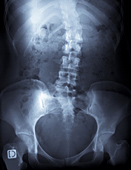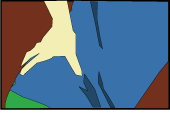The Multifidus Muscle - Key to Spinal Stabilization?
Monday January 12, 2009
Recently, researchers at UC San Diego used laser to measure the strength of the multifidus, a small muscle in the back. The results, published in the
Journal of Bone and Joint Surgery, may influence the future of medical science as it relates to back pain and spine surgery. The research was supported by the Department of Veterans Affairs Rehabilitation, the National Institutes of Health and DePuy Spine, a device manufacturer.
Up until now, the thinking has been that because the multifidus is very small, it isn’t important to back health. Size aside, the multifidus has a very unique design that lends stability to the spine and keeps the individual upright. The researchers in this study concluded that the special design provides a scaffolding for the vertebral column. They identified short stiff muscle fibers packed inside a long finger-like covering, and said this particular construction is responsible for the extra strength and support the multifidus gives to the spine.
A small 2006 posture study published in the European Spine Journal, found that in people with back pain, the multifidus is working to the max well before the spine is vertical. In study subjects who didn’t have back pain, the multifidus was able to continue contracting until the trunk was erect.
Read more...Weight Loss to Reduce Back Pain?
Thursday January 1, 2009

|
Photo: Justin Sullivan
Getty Images |
Well, we made it to 2009. You know what that means! Yes, it's time for resolutions. I am all about averting the back pain that gets in the way of what I choose to do. So along with a few suggestions on how to tame the beast, take a look at my article entitled Obesity and Back Pain. It explains how being overweight may contribute to your pain. Hopefully, it will fuel your motivation to get to and stay at a healthy weight.
Next year, smoking and back pain! (Think intervertebral disks.)
Cognitive Behavorial Therapy
Friday December 26, 2008
Cognitive behavioral therapy is a short term therapy in which you can learn coping skills. It has an excellent track record for people with chronic low back pain. In cognitive behavioral therapy, your therapist is there to help you confront and change the irrational thoughts that stop you from adapting yourself to your pain. In other words, you are not addressing the pain directly. Instead, you are learning ways to reframe the way you think about the pain. This may help you destress, which could possibly help with the pain. CBT is most effective when it is one component of your
pain management plan. If you choose to try this type of counseling, it’s best to locate a licensed mental health professional, rather than a lay person.
| More Info on CBT | Emotional Well-Being When You Are In Pain - Can They Exist Together? | The Multi-Disciplinary Approach |
Scoliosis Stapling
Wednesday December 17, 2008
 |
| Photo: (c) ldambies |
A big concern with
spinal fusion surgery, which is used for several types back problems, is that movement in the area of the surgery is forever eliminated as part of the deal. Spinal fusions are given to children (and adults) with excessive
scoliosis. But imagine looking at your toddler’s future knowing that she will never be able bend some or most of her spine.
Children with moderate scoliosis are often given braces, which can help stop the progression of the curve. But this treatment is awkward and embarrassing for a growing child. It also stops short of reversing the curve.
At the Center for Early Onset Scoliosis at Morgan Stanley Children's Hospital of NewYork-Presbyterian, Dr Michael Vitale and his colleagues see about 400 scoliosis patients under the age of five each year. Many of the children are treated with a new, minimally invasive technique called spinal stapling. The procedure uses fluoroscopy and tiny incisions to implant staples on the vertebral bodies. (Minimally invasive surgery has the advantage of small scars and easier healing because muscles are only slightly disturbed in the process.) The surgery takes about two hours to complete and can be done on girls up to the age of 14 and boys up to the age of 16. The curve must be 30 degrees or less.
Spinal stapling is one of several new treatments for scoliosis, according to press materials. Vitale says, “while most children do well with spinal fusion, we are on the cusp of a new era in the treatment of scoliosis. For the first time, we have a way to potentially reverse the scoliosis."






